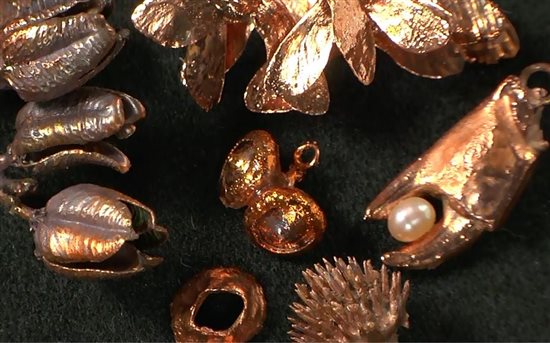
Electroforming: A Fusion of Science, Art, and Innovation
In the world of handmade crafts, few processes combine the elements of art, chemistry, and electrical engineering as seamlessly as electroforming. This fascinating technique, often used in jewellery-making, sculpture, and even industrial applications, transforms (organic) materials into metallic masterpieces by using the power of electricity. From humble beginnings to becoming an essential tool for artists and creators, electroforming stands as a testament to the ingenuity of both scientists and artisans.
In this article, we will explore the science behind electroforming, its historical evolution, and its place in modern artistic practice, shedding light on why it remains a captivating and vital technique for creators today.
The Science of Electroforming: Electricity as a Crafting Tool
At its most basic level, electroforming is the process of depositing metal onto a conductive surface through the application of an electric current. It relies on the principles of electrolysis—the breakdown of a compound through the application of electrical current. The science behind electroforming is a combination of electrochemical reactions that occur when an object is immersed in an electrolyte solution containing metal ions.
Understanding the Electroforming Process
-
Electrolysis and Metal Deposition:
When an electric current passes through an electrolyte solution, it causes the metal ions within the solution to migrate towards a negatively charged object (the cathode). This object must be conductive to attract the metal ions. As the ions are reduced (or gain electrons), they deposit onto the object’s surface, gradually building up into a thicker metal layer. This is the foundation of the electroforming process.
-
Electroforming vs. Electroplating:
Although electroforming and electroplating both use electricity to deposit metal onto a surface, the two processes differ in their intent and results. Electroforming builds up thick layers of metal, creating a substantial and durable coating, while electroplating is used to apply thin coatings for aesthetic purposes. Electroforming’s thicker layers make it suitable for creating sculptural and structural pieces that can hold more weight and detail.
-
Electrolyte Solution Composition:
The electrolyte solution used in electroforming typically contains metal salts, such as copper sulphate for copper electroforming. The quality of the electrolyte, its acidity or alkalinity, and the presence of additives influence the evenness and quality of the metal deposit. The process can be slow, as it takes time for the ions to accumulate and form a solid layer. Patience is key when working with electroforming.
-
Role of Current and Voltage:
The amount of current and the voltage applied during electroforming are crucial in determining the final result. Too much current can cause the metal to deposit too quickly, resulting in a rough or uneven finish, while too little can result in a thin or insufficient coating. Adjusting these variables is vital for achieving a smooth and uniform layer. This level of precision, which requires an understanding of electricity and chemistry, makes electroforming an art form in itself.
The History of Electroforming: From Industrial Beginnings to Artistic Mastery
The roots of electroforming can be traced back to the early days of electricity and chemical science. While electroplating was first demonstrated in the 18th century, electroforming as a distinct technique began to take shape in the 19th century, coinciding with the rise of modern chemistry and industrialisation. The development of electrolysis paved the way for a variety of applications, from the creation of durable parts to decorative artistry.
Origins and Development
-
Early Discoveries and the Birth of Electroforming:
In 1838, Boris Jacobi, a Russian scientist, discovered a method for depositing copper onto objects using electrical current. His technique became the precursor to electroforming and was initially used for industrial applications, such as creating printing plates. By the mid-1800s, this process was refined and applied to ornamental crafts, allowing artisans to coat intricate objects with a metal shell.
-
Electroforming in the Art World:
The use of electroforming for artistic purposes flourished in the late 19th and early 20th centuries, as artists and craftsmen sought new ways to enhance their designs. One of the most notable uses of electroforming during this period was the creation of ornamental objects—everything from jewellery to decorative home goods. The ability to encase fragile objects, such as flowers, leaves, or other natural materials, in metal, captivated the artistic community.
This was particularly useful in Art Nouveau and Art Deco movements, where designers sought to combine nature with modern aesthetics. The technique allowed artists to preserve organic forms in a way that traditional casting or sculpting methods could not.
-
Electroforming in Modern Art and Industry:
In the 20th century, as the technique evolved, it found its place in both fine art and industrial design. Artists like Alexander Calder embraced electroforming for its capacity to create sculptures that combined both organic shapes and industrial materials. In the world of industrial design, electroforming became integral in creating detailed components for scientific instruments, clocks, and more.
Today, electroforming is used by contemporary jewellery makers, sculptors, and mixed-media artists to create pieces that explore themes of nature, growth, and transformation. The practice remains integral to the production of handmade, bespoke works that blend the organic and the industrial.
The Art of Electroforming: Creativity Through Metal and Electricity
Electroforming is far more than just a technical process—it’s an artistic endeavour that requires a deep understanding of material science, patience, and a strong sense of creativity. The ability to take a natural object, such as a leaf, a seed, or even a piece of coral, and preserve it in metal, is where electroforming shines as an art form.
Artistic Applications of Electroforming
-
Nature as Inspiration:
Many contemporary artists use electroforming to preserve the delicate beauty of natural objects, turning them into durable, metallic treasures. Leaves, flowers, and even insects are often chosen for their intricate structures and the ability to encapsulate them in metal, preserving their form for eternity. These works celebrate the fleeting beauty of nature and transform it into something enduring and timeless.
-
Transforming Everyday Objects into Art:
Beyond natural materials, electroforming can be used to transform almost any object into a metallic sculpture. Artists often use found objects, such as broken jewellery, gears, or even discarded tools, and apply electroforming to enhance or elevate them into art. This concept, which blends upcycling and artistry, is a hallmark of electroforming’s artistic appeal.
-
Combining Materials for Unique Textures:
Electroforming also allows artists to combine different materials, such as gemstones, crystals, and resins, with the metal layer. This fusion of materials creates unique textures and contrasts that would be impossible to achieve with traditional methods. The metal not only serves as a shell but also becomes part of the artwork’s visual language, reflecting light, shadow, and texture in ways that enhance the piece’s overall aesthetic.
The Future of Electroforming: A Crossroads of Innovation and Tradition
As the world continues to embrace sustainability and innovation, electroforming presents a unique opportunity for artists and makers to repurpose materials and create items that are both functional and artistic. The rise of handmade jewellery, eco-conscious fashion, and bespoke design has made electroforming even more relevant, as it allows for the creation of custom, durable pieces with an added level of artistic depth.
The future of electroforming may also see new technological advancements that make the process more accessible and efficient. As 3D printing and digital modelling continue to revolutionise the arts, artists may integrate these technologies with electroforming, creating works that combine the digital and physical worlds in exciting new ways.
Why Electroforming Matters: A Lasting Artistic Legacy
Electroforming is more than a technique; it is a bridge between the past and the present, between science and art. The practice invites us to consider how objects, materials, and forms can be transformed through the interplay of electricity and creativity. Whether you're an artist, a maker, or simply an admirer of fine craftsmanship, electroforming is a powerful reminder of the endless possibilities that arise when artistry embraces science.
Through the careful and deliberate application of metal, electricity, and imagination, electroforming continues to shape the future of art, offering a new way to look at the materials around us and create works that are both beautiful and enduring.
Sources
https://en.wikipedia.org/wiki/Electroforming
https://www.firstdensitymaterial.com/blogs/news/the-art-of-electroforming-then-and-now
https://nickelinstitute.org/media/1674/electroforming_auniquemetalfabricationprocess_10084_.pdf
https://en.wikipedia.org/wiki/Electroplating
https://copper.org/consumers/arts/2007/november/Artists_Alchemists_Art_Copper_Electroforming.php
